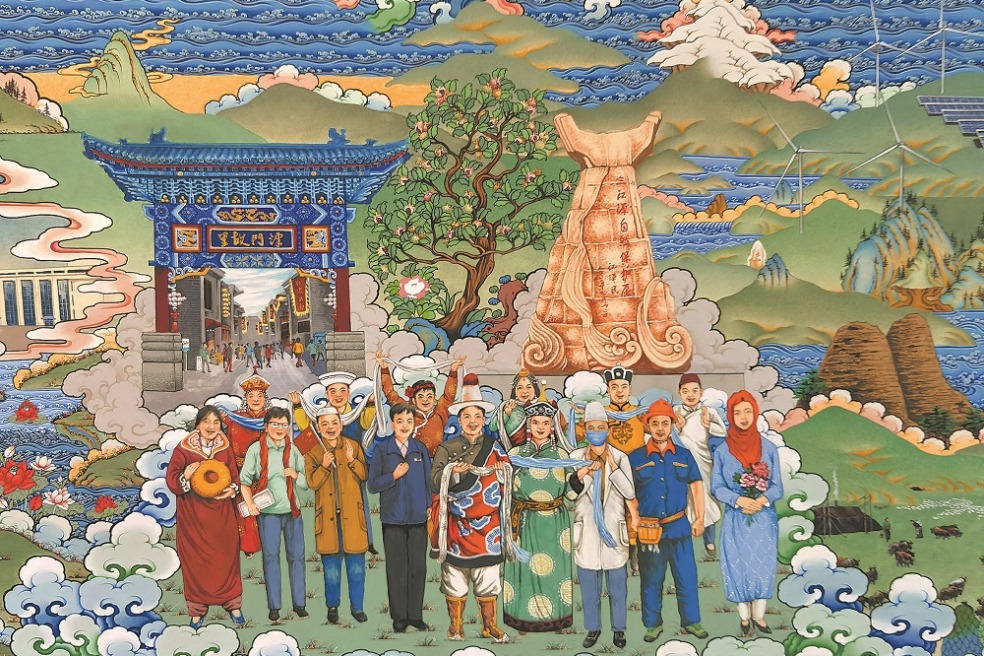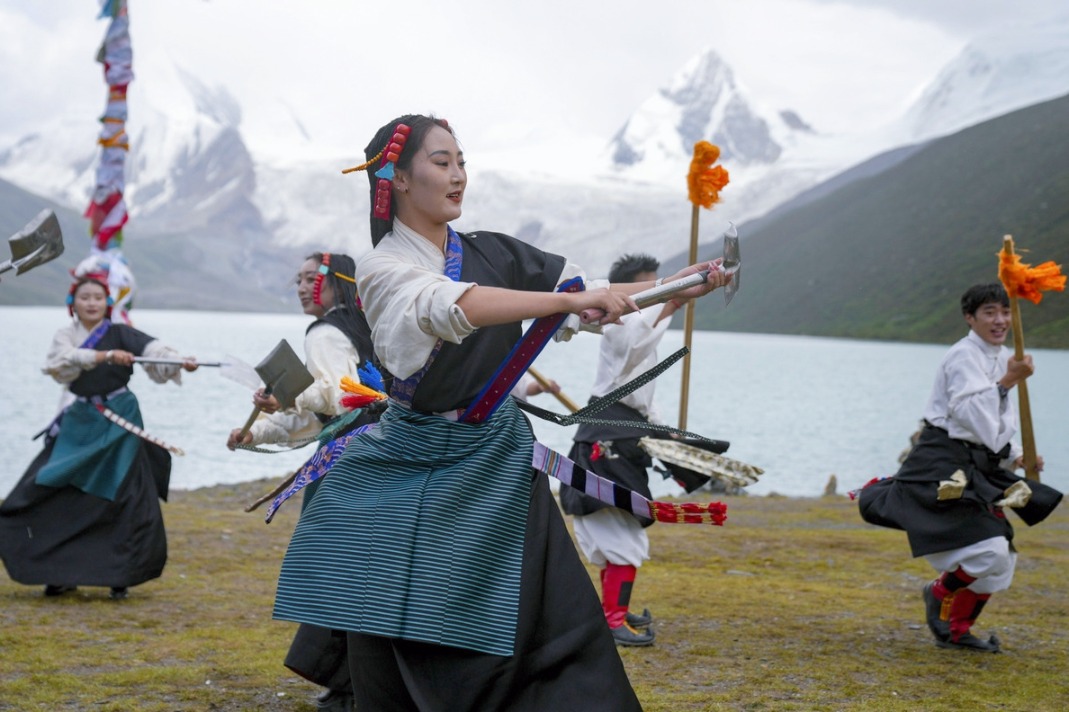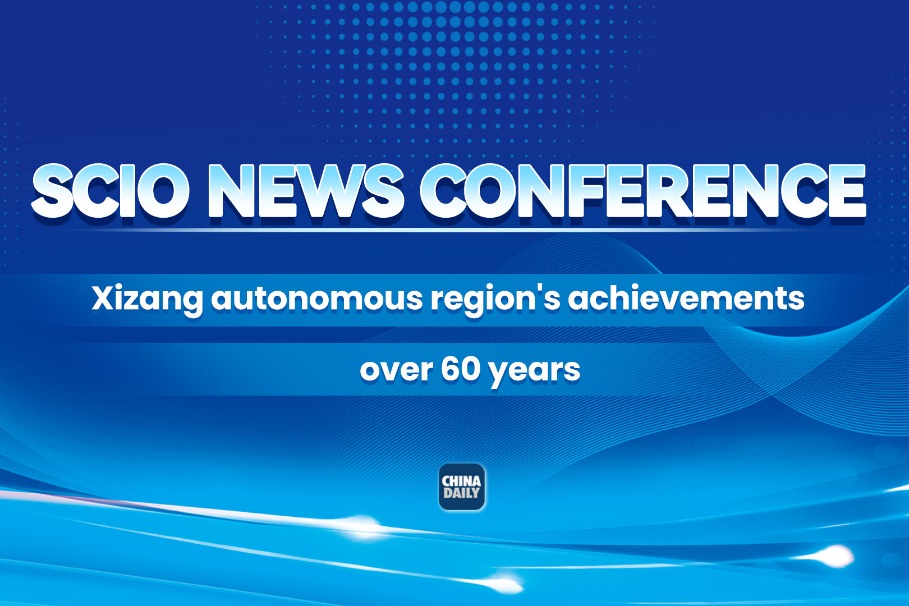Artist displays pride in culture
Thangka tradition motivates painter to show world its essence, Mingmei Li reports in New York.

Once he was a 12-year-old boy painting strokes and grinding pigments from dawn till dusk. Four decades later Nyingbum is a thangka master, passing on the ancient technique to a new generation.
Nyingbum recently concluded his latest exhibition, Inheritance and Beyond, in New York, presenting 16 pieces celebrating Tibetan Buddhism — a culture deeply tied to the Xizang autonomous region, known for its towering mountains and sweeping river valleys.
The exhibition, held at the Rockefeller State Park Preserve art gallery in Pleasantville, New York, in the Hudson Valley, mirrored the essence of Northwest China, particularly Qinghai province, and Xizang in Southwest China, with its picturesque terraces, plateaus, rivers and mountains, at a gentler elevation, making Nyingbum's art "feel like home".
"I feel truly proud as an artist bringing such rich cultural heritage to the United States and the world," said Nyingbum, 53.
"It's more than just art; it's a historical record. This painting tells the stories of the past. I want more people to see the value of thangka art ... and understand its beauty. I believe people will appreciate it, learn to preserve and build upon it, and share it," he said at the exhibition, which concluded last month.
Thangka is a traditional style of Tibetan painting on silk or cotton, usually depicting a Buddhist deity, scene, or mandala. They are religious paintings usually with a bamboo-cane rod pasted on the bottom edge by which it can be rolled up.
Regong arts, which include Regong thangka painting, clay sculpture, applique, and wood and stone carving, have been passed down through generations by local artisans. The distinctive arts originated from the Regong region of Qinghai province and extended to nearby provinces.
They were recognized as a national intangible cultural heritage in 2008 and were enlisted by UNESCO on its Representative List of the Intangible Cultural Heritage of Humanity in 2009.
Growing up in the Regong region of the Huangnan Tibetan autonomous prefecture in southeastern Qinghai, Nyingbum's family and village faced poverty. With two younger brothers and four elder sisters, he took on the responsibility of supporting his family and began an apprenticeship under thangka master Shawo Tsering, who was a student of renowned artist Zhang Daqian, one of the most famous Chinese artists of the 20th century.
Initially, painting thangka was merely a way for Nyingbum to earn money, but he soon developed a deep passion and talent for it. Over the years, he became dedicated to studying Regong thangka painting.
In August 2006, he established and became the director of the Qinghai Huangnan Regong Painting Institute, the first thangka art institute in the region.
"Our goal in starting this institute was to open up learning opportunities for more people," he says. "Traditionally, this art was passed down within families, from father to son, but that just wasn't enough.
"At first, I could only take in about a dozen kids to study at my place, but now we can accept more than 70 each year."
The institute covers 120,000 square meters with a building area of 7,000 sq m focusing on protecting, preserving and promoting the intangible cultural heritage of Regong thangka, as well as training local artists. He says the large space allows more children to learn and engage with the art.
"Every year, we check how many students graduate and how many new kids we can take in. Our institute is really here for kids from low-income families, the 'left-behind' children (who remain in rural areas while their parents migrate to cities for work). We cover their meals, housing and education, all free of charge," he says.
The institute has been recognized as a national cultural industry demonstration base, a national intangible cultural heritage productive protection demonstration base, and a youth employment and entrepreneurship training base.
"Painting thangka is time-consuming and requires sincerity and patience," he says. "It takes an artist weeks, or even months, to finish a painting."
The pieces he brought to New York took an average of two to three months each to complete. They featured not only the vibrant, colorful Buddhist figures, but also the line-drawn sketches. These paintings displayed detailed color-mixing techniques that Nyingbum uses, with precious mineral pigments like gold, silver and cinnabar, along with natural dyes from plants, such as saffron and gardenia, which can make the art last for decades.
"It's amazing to see how so many beautiful works have been preserved because artists used mineral pigments," Nyingbum introduces. "Take the murals at Dunhuang, Gansu province, or the Potala Palace in the Xizang autonomous region, for example. They've stayed vibrant for hundreds of years without fading. That's something unique about our Eastern murals."
The use of natural mineral pigments allows thangka paintings to endure for millennia, giving them exceptional collectible value. The high-quality materials are also costly.
He says that the use of the pigments makes the art form hard to replace with today's digital painting — thangka art has strict requirements for color-mixing, outlining and more. It not only requires the meticulous techniques of traditional Chinese painting but also demands the artist's skill in grinding pigments and controlling temperature and humidity.
When painting Buddhist figures, Nyingbum likes to use bold, exaggerated colors on the statues' graceful forms, blending reality with imaginative settings to create a vivid artistic world. In contrast, when depicting real-life scenes, he uses natural colors to capture the simplicity of the landscape.
"These aren't just basic watercolors or oil paint colors — they are all carefully mixed and ground by hand. The process is complex. We need to grind the minerals daily; even small changes in pressure can subtly shift the color. For example, heavier grinding might produce one shade while a lighter grind gives you another," he says.
"Each step — drafting, coloring, shading, adding gold lines and drawing fine details — tests the artist's skills. The artist has to keep learning all the time: studying Buddhist culture, understanding the deeper meaning and putting real heart into thangka," he says. "We need to continue to refine our artistry and learn."
The thangka art form has more than 2,000 years of history in Tibetan and Buddhist-related culture. "The core message of thangka painting is to be kind and to do one's best to help others," says the artist.
It has been his faith that helped him persevere all these years and be committed to introducing this niche art form to more people, he adds.
He traveled to Chengdu, Sichuan province, from 1995 to 1997 to deepen his understanding of traditional Chinese gongbi painting techniques that require careful, meticulous depiction. He believes that thangka holds great potential for creativity, capable of portraying many aspects and fields, such as astronomy and geography, bridging ancient and modern themes.
To celebrate the Beijing 2008 Summer Olympics, the artist created three paintings of the Fuwa mascots that year, later collected by the Beijing Olympic Committee.
In 2009, he painted two works, Princess Wencheng's Journey to Tibet, symbolizing unity between the Han and Tibetan ethnic groups, and The Founding Ceremony, celebrating the establishment of the People's Republic of China in 1949, both donated to the State Council.
That year, he also created The Tenth Anniversary of Macao's Return to China, which he donated to the Macao Special Administrative Region. He received the first Chinese Youth Arts Award in 2011 and in 2013 earned the title of Chinese Master of Arts and Crafts, granted by the State Council.
"Creating works with such themes fills me with pride," says the Tibetan artist. "These pieces reflect the harmony and unity among our nation's 56 ethnic groups. Anyone who sees them feels a deep connection."
Promoting thangka art overseas is difficult, he says, but his passion for sharing its beauty keeps him motivated. "It's my responsibility and I hope this Tibetan culture can be preserved by more artists," he says.
"Art knows no borders and this painting technique is truly rare. We hope that thangka art can be appreciated and loved by more people in the US and the world."
Philanthropist Steven Rockefeller, host of the exhibition, who represented the Rockefeller family's support for the event, says that the parallels of the dramatic natural landscapes served as symbolism to the harmony of all our best efforts in cultural exchange.
Lily Li, organizer of the event, says that "bringing Nyingbum's art to New York is a monumental occasion. This city, a global hub of art and culture, provides the perfect platform to introduce thangka to an eager new audience".
"It underscores the importance of preserving such traditions in our rapidly globalizing world, fostering a culture of sharing that enriches us all," Li adds.
"This exhibition is more than a display of artistic mastery. It is a celebration of a man whose life's work bridges the gap between ancient traditions and the modern world."
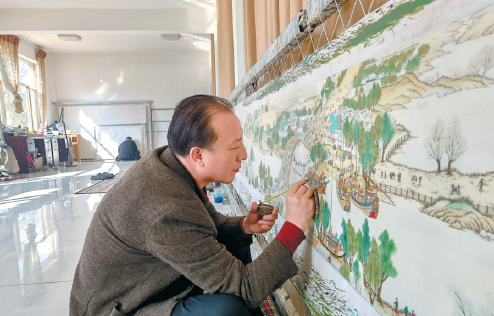
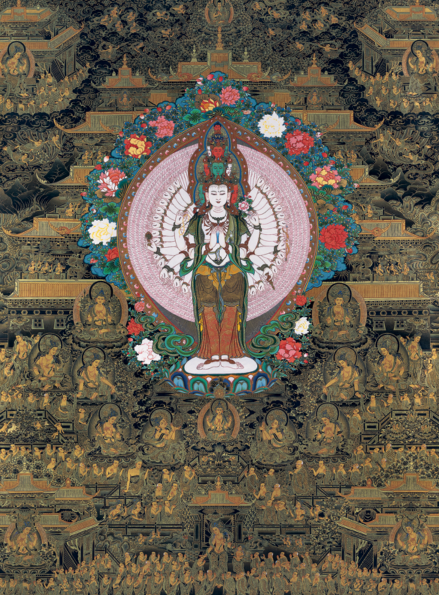
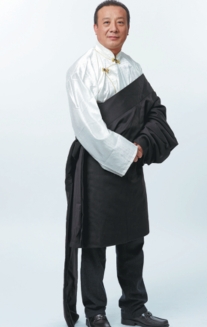
Today's Top News
- Hong Kong advances as global asset management hub
- Chili peppers every day can keep the doctor away
- Steel sector makes strides in profitability
- Rescue underway for trapped in landslide
- Japan needs to match words with deeds to prove it has learned Hiroshima lessons
- Pharmaceutical levies won't prompt reshoring: China Daily editorial


















